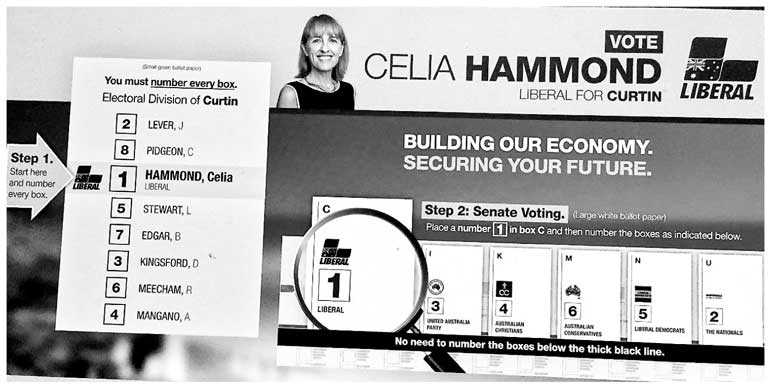Monday Mar 17, 2025
Monday Mar 17, 2025
Saturday, 4 May 2019 00:00 - - {{hitsCtrl.values.hits}}

A typical candidate leaflet
 The federal – or in jargon ‘general’ – election in Australia will be held in a fortnight, on Saturday 18 May to elect 150 members for the House of Representatives and 76 for the Senate.
The federal – or in jargon ‘general’ – election in Australia will be held in a fortnight, on Saturday 18 May to elect 150 members for the House of Representatives and 76 for the Senate.
The eligible voters have been sent an official guide explaining how and where one can vote.
Voting is compulsory for all citizens over 18 years of age. Those who fail to vote are prosecuted unless a valid reason is given as to why they couldn’t vote.
Polling places (booths) are housed in local schools, churches, community halls and other public places. A voter can check his or her polling place on the internet. The major newspapers of the area will carry details of the polling places the day before the election.
Voting will begin at 8 a.m. and close at 6 p.m.
The Australian Electoral Commission which conducts the election has taken every effort to make it convenient for the voter. With the facilities for pre-poll voting it was reported last week that around 375,000 people have already cast their vote within the first three days of early voting which began on Monday 29 April.
This amounts to approximately 125,000 votes per day. This figure is much more than the early voting during the 2016 federal election when the number in the first three days averaged at 225,000.
 Early voting is permitted for those who can’t make it to a polling place in his state or territory on Election Day. It can be done either in person or by post. Voting before Election Day can be done at an early voting centre, with a mobile team or an Australian overseas voting centre. Anyone eligible for a postal vote has to apply early and get an application form from any Electoral Commission office.
Early voting is permitted for those who can’t make it to a polling place in his state or territory on Election Day. It can be done either in person or by post. Voting before Election Day can be done at an early voting centre, with a mobile team or an Australian overseas voting centre. Anyone eligible for a postal vote has to apply early and get an application form from any Electoral Commission office.
The Commission advises that candidate representatives may offer how-to-vote cards suggesting that the voter votes in a particular way but the voter does not have to accept or follow those cards. In fact, candidates have delivered propaganda material in the form of such cards. A sample card has been printed in the official guide for the voter to get an idea how the card looks.
The voter has two ballot papers to fill – one in green and the other white. The green one is to vote for a representative of the local area or electorate in the House of Reps. The white one is to vote for representatives of the state or territory in the Senate.
In total 16,424,248 Australians are enrolled to vote – an increase of over 750,000 from the last election in 2016 when the figure was 15,671,551. The turnout was 91.01%.
Discover Kapruka, the leading online shopping platform in Sri Lanka, where you can conveniently send Gifts and Flowers to your loved ones for any event including Valentine ’s Day. Explore a wide range of popular Shopping Categories on Kapruka, including Toys, Groceries, Electronics, Birthday Cakes, Fruits, Chocolates, Flower Bouquets, Clothing, Watches, Lingerie, Gift Sets and Jewellery. Also if you’re interested in selling with Kapruka, Partner Central by Kapruka is the best solution to start with. Moreover, through Kapruka Global Shop, you can also enjoy the convenience of purchasing products from renowned platforms like Amazon and eBay and have them delivered to Sri Lanka.
Discover Kapruka, the leading online shopping platform in Sri Lanka, where you can conveniently send Gifts and Flowers to your loved ones for any event including Valentine ’s Day. Explore a wide range of popular Shopping Categories on Kapruka, including Toys, Groceries, Electronics, Birthday Cakes, Fruits, Chocolates, Flower Bouquets, Clothing, Watches, Lingerie, Gift Sets and Jewellery. Also if you’re interested in selling with Kapruka, Partner Central by Kapruka is the best solution to start with. Moreover, through Kapruka Global Shop, you can also enjoy the convenience of purchasing products from renowned platforms like Amazon and eBay and have them delivered to Sri Lanka.